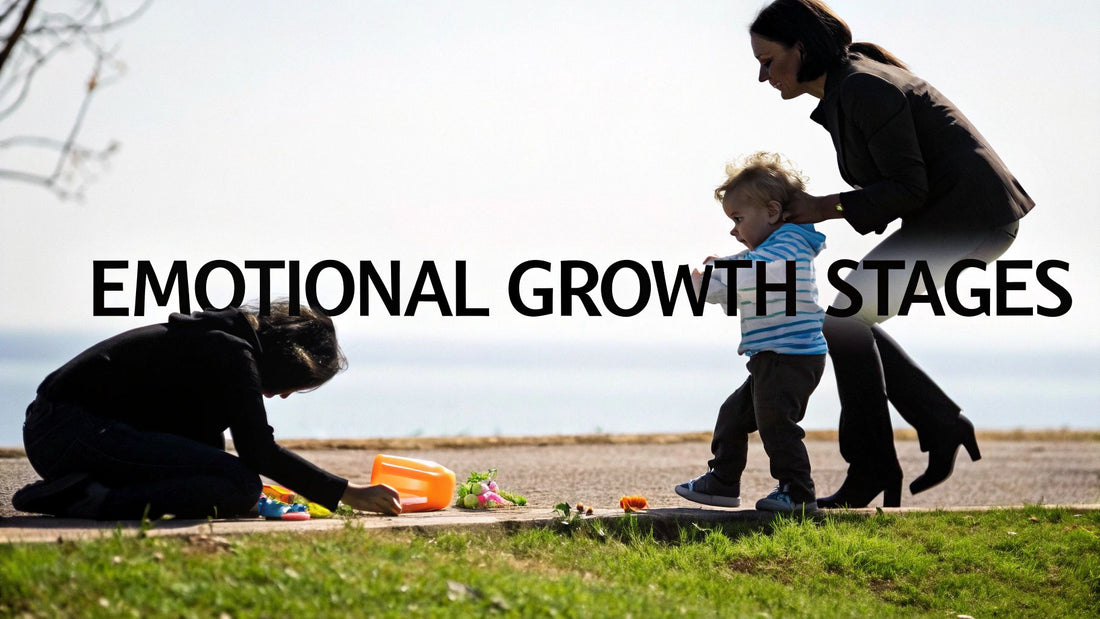
A Guide to Child Emotional Development Stages
Share
Child emotional development is the journey our little ones take as they learn to understand, express, and manage their feelings. It’s a bit like learning to walk or talk – a natural progression from the simple emotions of a baby to the complex social skills needed for a happy, well-adjusted life. This guide is here to offer a clear map for that journey.
Why Your Child's Emotional Journey Matters
Watching your child grow emotionally can sometimes feel like trying to navigate a tricky path without a compass. But this journey isn't as random as it might seem. It unfolds in a series of predictable stages, and nurturing this side of their development is every bit as important as looking after their physical health. It's the foundation for their future wellbeing.
If you find yourself worrying about your child's mental and emotional health, you're in good company. A recent NSPCC survey revealed that a staggering 75% of parents with children under five feel anxious about it. Addressing mental health from an early age is vital, as it sets the stage for resilience and emotional stability in later life.
This guide will walk you through it all, from the essential trust built in infancy to the complex emotional world of a teenager.
The Building Blocks of Emotional Health
Emotional development is a cumulative process, with each stage building firmly on the one before it. Think of it like building a house: you can't put up the walls and roof without first laying a solid foundation. In the same way, a child needs to feel safe, secure, and understood in their early years to develop more complex emotional skills later on.
The infographic below gives a brilliant overview of the three core phases of this journey.
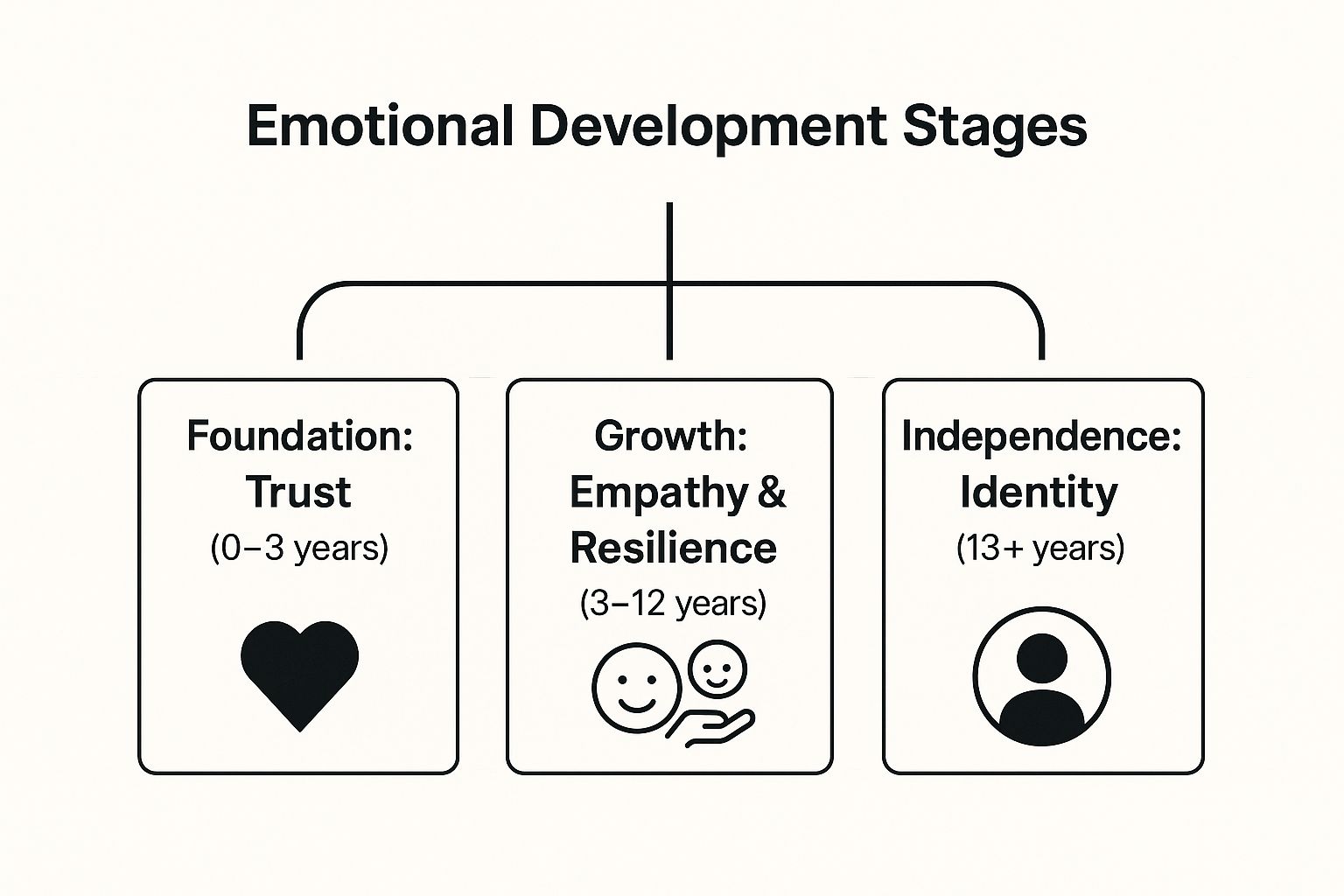
As you can see, a child's focus naturally shifts over time – from establishing trust, to growing in empathy, and finally to carving out their own unique identity.
To give you a clearer picture of what's ahead in this guide, here's a quick look at how these stages break down.
Emotional Development Stages at a Glance
This table summarises the primary emotional focus for each age group and the key role you, as a caregiver, play in supporting them.
| Age Group | Primary Emotional Focus | Key Caregiver Goal |
|---|---|---|
| Infants (0-1) | Building trust and attachment. | Provide consistent, responsive care. |
| Toddlers (1-3) | Developing autonomy and self-awareness. | Offer choices and support independence safely. |
| Preschoolers (3-5) | Understanding and naming emotions. | Help them label feelings and build empathy. |
| School-Age (6-12) | Developing emotional regulation and social skills. | Coach them through social challenges and coping strategies. |
| Adolescents (13-18) | Forming identity and navigating complex social emotions. | Be a supportive guide for their growing independence. |
Each of these stages represents a new chapter in your child's emotional story, and we'll be exploring them all in much more detail.
A Note on Professional Advice
Supporting your child's emotional health is one of the most vital roles you will ever have. My goal with this guide is to offer practical insights, real-world examples, and genuine support to help you feel more confident along the way.
Please remember, I am not a mental health professional. The information here is for educational purposes and isn't a substitute for professional medical advice. If you have serious concerns about your child’s emotional wellbeing, it is always best to chat with your GP or a qualified healthcare provider.
At the end of the day, you know your child best. Trust your instincts. Seeking professional help is a sign of strength and a positive, proactive step towards supporting their overall health and happiness.
Building Trust in the Foundation Years (0-3 Years)
The first three years of your child's life are, without a doubt, some of the most important in their entire emotional journey. This period isn't about grand gestures or dramatic events. Instead, it's built on the quiet, consistent, everyday moments that create a profound sense of safety and security. Think of it like laying the concrete foundation for a house; when a child feels safe, loved, and knows their needs will be met, they form a secure attachment that will support their emotional health for the rest of their life.
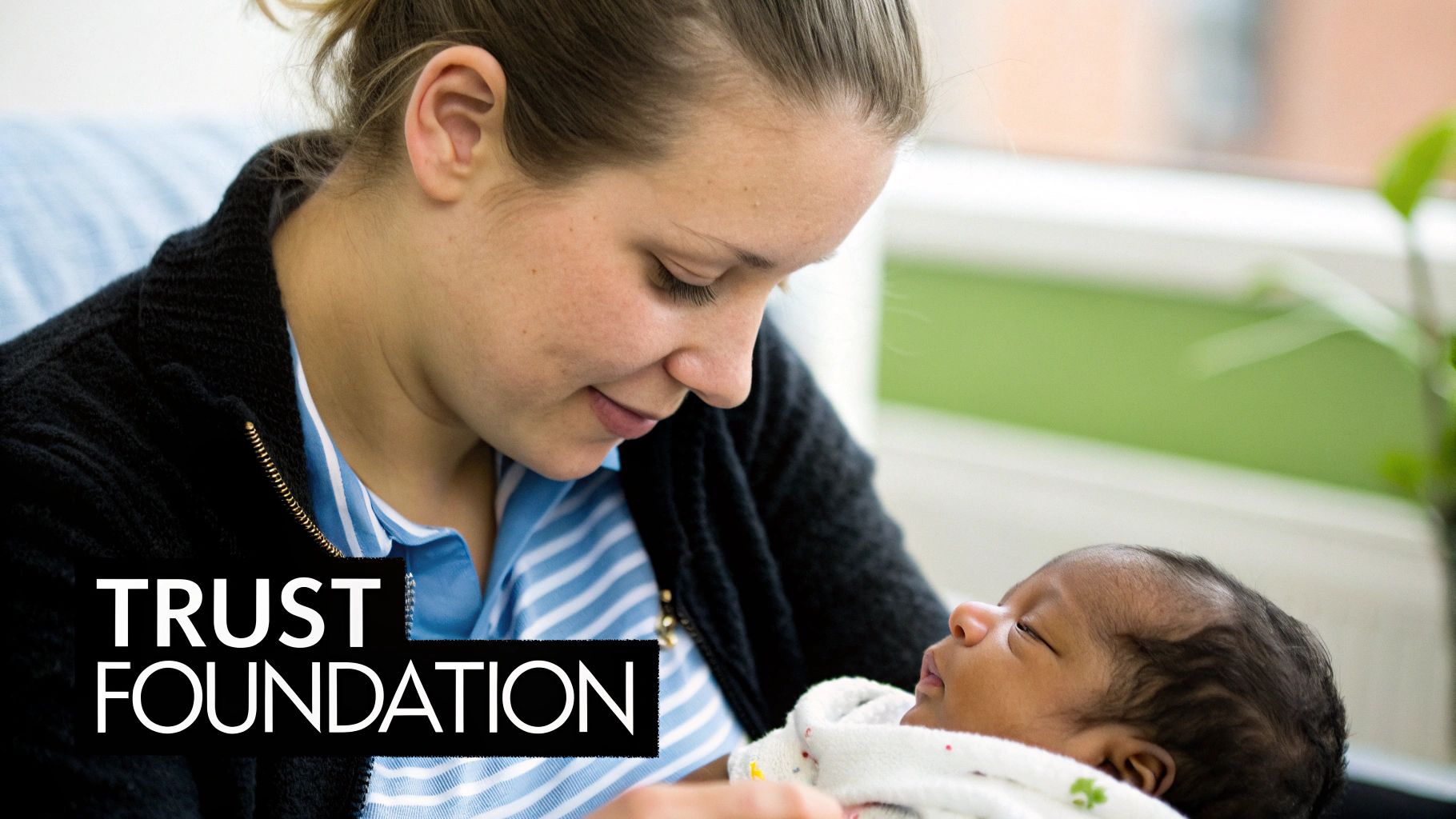
From the moment they're born, babies use crying to communicate everything. When we respond to those cries—whether they're for food, a cuddle, or a nappy change—we're teaching them their very first and most vital emotional lesson: the world is a safe place, and their needs matter. This reliable care is the very bedrock of trust.
As they grow, their inner world begins to blossom. A simple cry evolves into a whole spectrum of feelings. We see the magic of the first social smile at around two months old, a deliberate flash of joy in response to seeing a caregiver’s face. This is a massive milestone, marking the real start of a two-way emotional connection.
Navigating Key Emotional Milestones
Between six and nine months, something else significant starts to happen: separation anxiety. All of a sudden, your baby might become incredibly clingy or burst into tears the moment you leave the room. This isn't a step backwards; it's actually a brilliant sign of healthy attachment. They now understand that you are a separate person, and they miss your reassuring presence when you're gone.
As they approach their first birthday, toddlers start to assert their independence, which opens up a whole new world of emotions. Frustration becomes a frequent visitor as they try, and often fail, to master new physical skills. This is also when the dreaded tantrums can make their first appearance, and they are so often misunderstood.
A toddler's tantrum is not an act of defiance. It's an expression of an overwhelming emotion that their developing brain simply cannot process yet. They aren't giving you a hard time; they are having a hard time.
Seeing tantrums this way changes everything. It’s no longer a battle of wills but an opportunity to connect and teach. Your calm presence during their emotional storm shows them that big feelings are okay, they're manageable, and you are right there to help them through it.
Practical Tips for Building an Emotional Vocabulary
Your role during these foundation years is to be an "emotion coach." You can help your little one build a strong emotional vocabulary and learn the absolute basics of managing their feelings. Here are a few simple but powerful strategies:
- Mirror Their Feelings: When your toddler is upset, get down on their level and reflect what you see. Saying, "You look so frustrated that the blocks keep falling over," validates their feeling and helps them connect a word to it.
- Create Predictable Routines: Consistency is everything for young children. Predictable routines for meals, naps, and bedtime create a sense of order and security, which reduces anxiety and makes it easier for them to handle their emotions.
- Use Simple Language: Name emotions as they pop up in everyday life. For example, "Look at that happy dog wagging his tail!" or "I feel a bit sad that our playtime is over." This makes talking about feelings completely normal.
Reading together is another fantastic tool. Exploring engaging books about feelings for toddlers is a fun, gentle way to introduce ideas like sadness, anger, and happiness through stories and characters they can relate to. It gives you both a shared language to talk about emotions.
Remember, the goal isn’t to stop your child from ever feeling sad or angry. It's to show them that all feelings are acceptable and to give them the tools to express those feelings in healthy ways. By doing this, you're strengthening that secure foundation, making sure they have the confidence and emotional stability to navigate the more complex child emotional development stages that lie ahead.
Exploring Empathy in the Preschool Years (3-5 Years)
As children wave goodbye to toddlerhood and step into their preschool years, their world suddenly gets a lot bigger. Nurseries, friendships, and playdates introduce a whole new set of social and emotional puzzles to solve. This is the stage where they begin to look beyond their own bubble and realise that other people have thoughts and feelings too—this is the dawn of empathy.
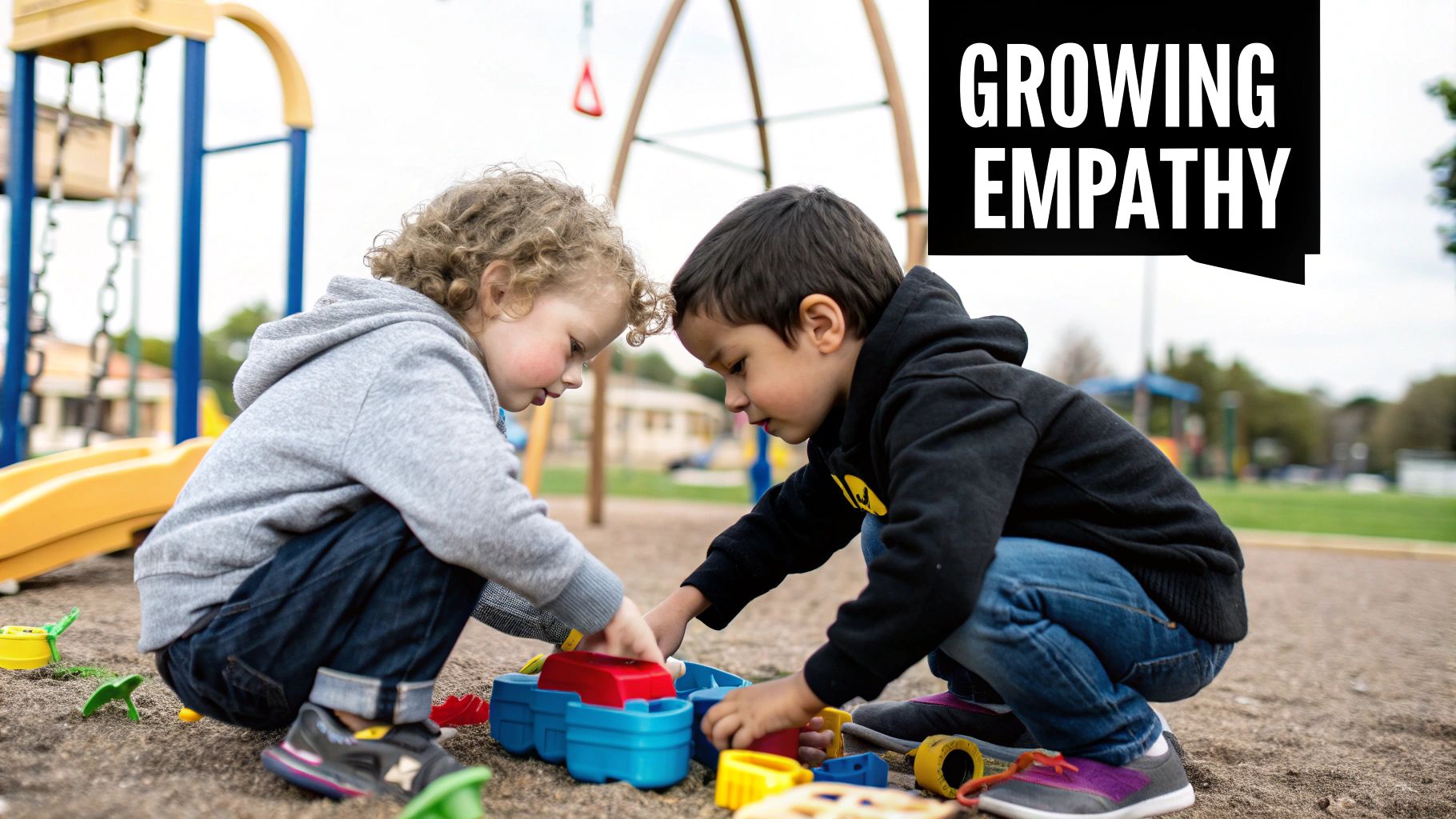
This leap is one of the most significant in all the child emotional development stages. Suddenly, ideas like sharing, taking turns, and cooperating become daily lessons. It’s not always a smooth ride; playground squabbles over a favourite spade or tears after losing a game are completely normal. In fact, they are essential learning opportunities.
These moments are the very building blocks of social skills. When a child starts to understand that grabbing a toy makes their friend sad, they are exercising their empathy muscle. It's a skill that needs to be coached and nurtured, not just expected to appear out of thin air.
Fostering Empathy and Social Skills
During this phase, your role shifts. You're not just coaching your child through their own big feelings anymore; you're also becoming a social guide for how they interact with others. The main goal is to help them connect their actions to the feelings of those around them. This takes patience and a lot of practical, in-the-moment guidance.
For instance, if your child snatches a crayon from a friend who then starts to cry, you can gently step in. Instead of simply demanding they give it back, try saying something like, "Look at Ben's face. He looks very sad because he was still using the blue crayon. How can we help him feel better?" This simple switch frames the situation around feelings, not just rules.
The ability to see things from another person's perspective is a cornerstone of emotional intelligence. By coaching children through social conflicts, we are not just solving a playground dispute; we are teaching a fundamental life skill that supports healthy relationships and mental wellbeing.
One of the most powerful ways to foster empathy is by talking about emotions openly and often. Weaving this into your daily routine helps normalise these conversations and builds a strong emotional vocabulary. You can learn more about this in our detailed guide on teaching emotional awareness to children.
Practical Strategies for Everyday Situations
Navigating this stage successfully means turning everyday challenges into teachable moments. Rather than just crossing your fingers and hoping they'll learn to share, you can actively equip them with the tools they need.
Here are a few practical strategies to try:
- Role-Play Scenarios: Practice makes perfect. Before a playdate, you could act out situations like asking for a turn with a toy or what to do if someone doesn't want to play their game. This gives them a script to follow when they feel unsure.
- Praise Cooperative Behaviour: When you see them sharing, taking turns, or comforting a friend, make a point of praising it. Say something specific, like, "It was so kind of you to share your cars with Maya. Look how happy she is!"
- Read Stories About Feelings: Books are a fantastic, low-pressure way to explore tricky social situations. Choose stories that centre on friendship, kindness, and resolving conflict, and take time to talk about how the characters might be feeling.
The importance of nurturing these skills cannot be overstated. Research shows that children with strong emotional skills are better equipped for school and life. Addressing mental health early is crucial; it helps prevent more significant issues down the line and builds a foundation for lifelong wellbeing.
Developing Resilience Through the School Years (6-12 Years)
The leap into primary school marks a massive shift in a child's emotional world. They're moving from the familiar, often sheltered environment of their early years into a much more complex social and academic landscape. Suddenly, their inner lives get richer and a lot more complicated.
They start to wrestle with conflicting feelings—like being incredibly proud of a drawing but terrified to show it to the class. This is the age they truly begin learning how to bounce back from life's inevitable knocks and disappointments.
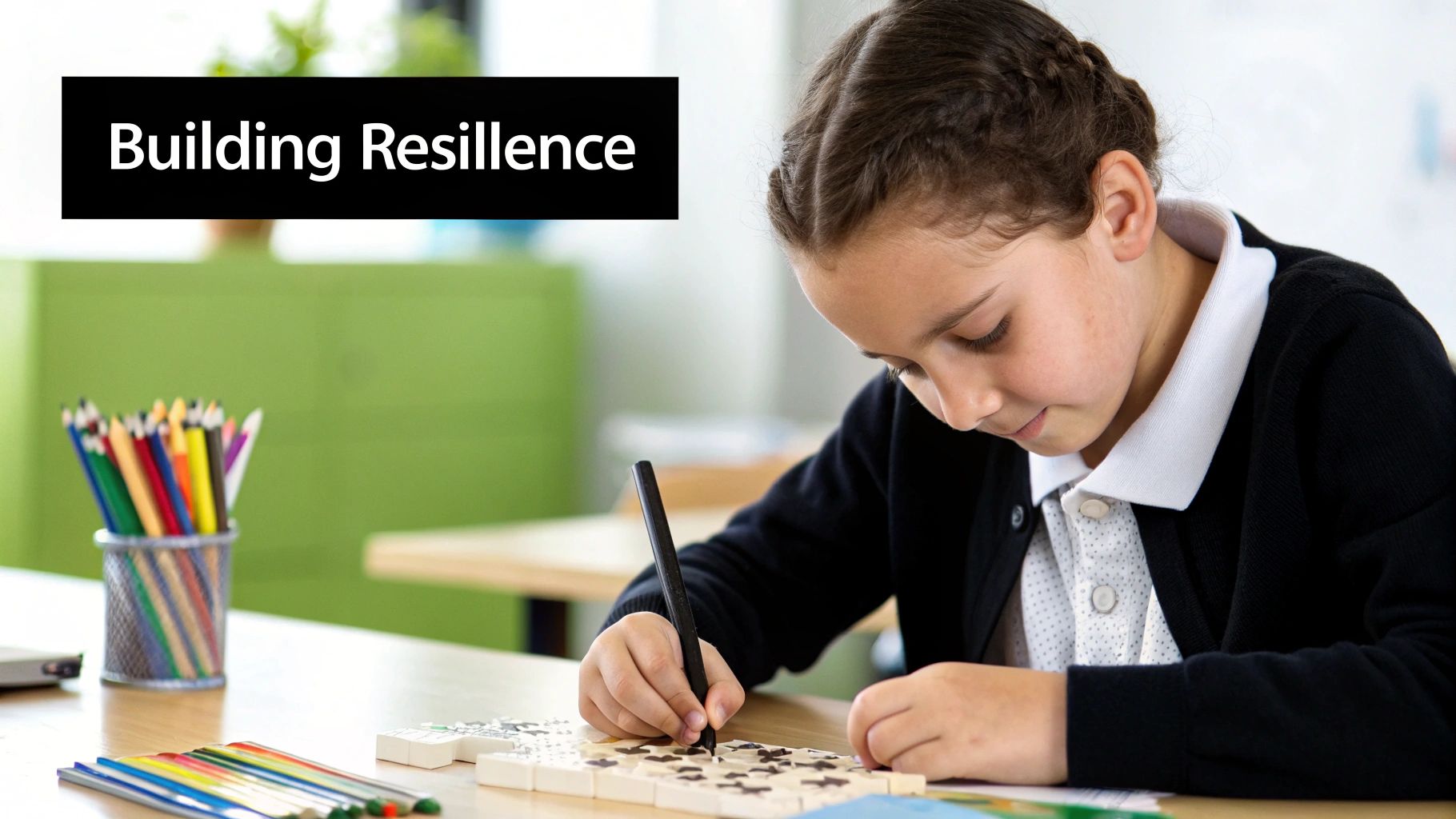
This stage is all about building resilience, which is really just the ability to adapt and recover when things get tough. It's an absolutely critical life skill, and these middle years are where its foundations are properly set. Things like academic pressure, navigating ever-changing friendship groups, and falling out with mates are no longer small bumps in the road; to a child, they can feel like major emotional earthquakes.
The Growing Influence of the Outside World
As children spend more of their day at school and with friends, the influence of peers and teachers starts to carry a lot more weight. They become keenly aware of social dynamics and naturally begin comparing themselves to others, which can be a real knock to their self-esteem.
This is also the age where the digital world starts to creep in. The rise of social media means children are exposed to curated, often unrealistic, versions of life earlier than ever, which can significantly impact their mental health and self-perception.
The focus on children's mental health has never been more vital. It's estimated that one in six children aged 7-16 in the UK now has a probable mental health problem. Looking at the bigger picture, this isn't just about individual wellbeing; it has huge societal and economic ripple effects. Poor mental health in the workforce, for instance, costs UK businesses an estimated £56 billion a year in lost productivity and sick days.
Your most powerful tool as a parent or carer is fostering open communication at home. Creating a safe, non-judgemental space where your child knows they can share their worries—whether it’s about a spelling test or a mean comment online—is absolutely paramount. To help with this, a comprehensive guide to building your child's confidence can offer some fantastic, actionable strategies.
Practical Tips for Supporting Emotional Health at Home
Teaching healthy coping mechanisms during these years is crucial. It’s about giving your child a toolkit they can dip into whenever they feel overwhelmed. This is a step beyond just naming feelings; it's about actively learning how to manage them.
Here are a few simple relaxation and communication techniques you can try together at home.
| Technique | Description | Practical Example |
|---|---|---|
| Mindful Breathing | Teach them to take slow, deep "belly breaths" to calm their nervous system. | "Let's pretend our tummy is a balloon. Breathe in slowly through your nose to make the balloon big, and then breathe out through your mouth to let the air out." |
| 'Worry Time' | Set aside 10-15 minutes each day just to talk about any worries. This helps contain the anxiety. | After school, you could say, "Let's have our 'worry chat'. Tell me one thing that's been on your mind today, and we can think about it together." |
| Creative Expression | Encourage drawing, writing, or building to express feelings they might struggle to find words for. | If they're angry, suggest, "Why don't you draw what your anger looks like? Give it a colour and a shape. It's okay to feel that way." |
| Problem-Solving Chats | Instead of jumping in with solutions, ask questions to empower them to find their own. | If they've fallen out with a friend, ask, "That sounds tough. What do you think you could do to make things a little better tomorrow?" |
Starting conversations about mental health can feel tricky, but simple, everyday things can help break the ice. Many parents find that mental health books on emotional topics or even items like mental health apparel with positive messages can act as a gentle conversation starter. These small prompts help to normalise talking about feelings and reduce any stigma within the family.
Disclaimer: It's important to state that I am not a mental health professional. The information provided here is for educational purposes only. If you are worried about your child's mental or emotional health, it is always best to seek help from your GP or a qualified healthcare provider. Reaching out for professional support is a sign of strength and proactive care for your child's future.
Navigating Independence in the Teenage Years (13+ Years)
Adolescence can feel like it arrives overnight, transforming the relatively calm landscape of childhood into a whirlwind of profound change. This journey towards independence is one of the most turbulent and vital of all the child emotional development stages. For teenagers, everything boils down to one fundamental question: "Who am I?", separate from their family.
This period is marked by an intense focus on friendships, a deep-seated desire for autonomy, and the challenging task of forging a personal identity. It's not just rebellion for rebellion's sake; hormonal shifts and a still-developing prefrontal cortex (the brain's decision-making centre) mean that mood swings, impulsivity, and heightened emotions are a biological reality.
The mental health of children and young people is a growing concern. It’s a shocking reality that one in five young people aged 8 to 25 had a probable mental health problem in 2023. These challenges have real-world consequences, with poor mental health costing UK businesses up to £56 billion annually. This is a stark reminder of just how crucial early support really is.
The Impact of Social Media
For today's teenagers, the quest for identity is increasingly played out online. Social media can be a complex and difficult space, acting as a constant mirror that reflects highly curated, often unrealistic versions of life. This can easily amplify feelings of inadequacy, social anxiety, and the classic 'fear of missing out'.
The pressure to present a perfect, filtered life can be immense, making it harder for teens to embrace their authentic, messy, imperfect selves. It's so important to foster open conversations about digital wellbeing and encourage a healthy balance between their online and offline worlds.
Navigating the teenage years requires a delicate balance. It's about slowly loosening the reins while still providing a strong, supportive safety net. Your role shifts from being a manager of their life to a trusted consultant they can turn to for advice.
To support them, try to create a family culture where talking about mental health is normal. Small, simple things, like wearing mental health apparel with positive messages, can act as gentle conversation starters. Similarly, having accessible mental health books on the bookshelf can give teens a private way to explore their feelings and realise they aren't alone.
Practical Tips for Staying Connected
Maintaining a strong connection during these years can feel tough as your teen naturally pulls away to form their own identity. But your support remains as critical as ever—you just need to adapt your approach.
Here are a few strategies to keep those communication lines open:
- Listen More Than You Talk: Often, teens don't actually want you to solve their problems. They just want to feel heard and understood. Try to practise active listening without immediately jumping in with solutions.
- Validate Their Feelings: Teenage emotions can seem overly dramatic from the outside, but they are incredibly real to them. Simple phrases like, "That sounds so frustrating," or "I can see why you're upset," show empathy and build trust.
- Choose Your Battles: Not every issue is worth a major conflict. Learn to differentiate between minor annoyances (like a messy room) and serious concerns that genuinely require your intervention.
- Find Shared Activities: Look for low-pressure ways to spend time together, whether it’s watching a film, walking the dog, or cooking a meal. These shared moments create natural, easy opportunities for conversation to flow.
Encouraging Healthy Relaxation
With mounting academic and social pressures, teaching teenagers healthy ways to relax and de-stress is an invaluable life skill that will serve them well into adulthood.
Here are some simple relaxation tips you can encourage:
- Mindful Tech Breaks: Encourage them to schedule time away from their screens to simply read, listen to music, or just sit quietly.
- Physical Activity: Exercise is a powerful mood booster. Whether it's a team sport, a bike ride, or a YouTube yoga class, getting moving helps release tension.
- Creative Outlets: Drawing, journaling, playing an instrument, or any creative hobby offers a brilliant way to process emotions without needing to find the words.
Ultimately, your goal is to be a steady, reassuring presence in their life. By validating their journey and providing unwavering support, you help them build the confidence they need to step into adulthood.
Please remember, I am not a mental health professional. If you are ever worried about your teenager's mental health or notice significant changes in their behaviour, it is always best to seek help from a doctor or a qualified mental health professional. Reaching out is a positive and courageous step.
Your Toolkit of Helpful Resources for UK Parents
Navigating your child’s emotional development is a journey, not a destination. It’s an ongoing process of learning and growing together, and it's so important to know that help and information are always there when you need a bit of extra support. Think of this as your personal toolkit, filled with trusted, UK-specific resources to empower you along the way.
Talking about feelings is a skill that helps everyone, and finding creative ways to weave these chats into daily life can make a huge difference. Things like mental health apparel with positive slogans or sharing powerful mental health books together can be gentle, everyday conversation starters that help chip away at any stigma.
Reliable UK Support Networks
When you need advice, knowing where to turn is half the battle. Thankfully, the UK has some incredible organisations dedicated to youth mental health. Charities like YoungMinds and the NSPCC are treasure troves of information and support for parents. For more structured help, the NHS offers dedicated Child and Adolescent Mental Health Services (CAMHS).
It's worth remembering that poor mental health has a ripple effect. Beyond the deeply personal impact, it costs UK businesses an estimated £56 billion a year in lost productivity. This really highlights just how crucial early support and intervention are for everyone in our society.
Practical Tools and Further Reading
Sometimes, you just need the right tool for the job. Building a child's emotional vocabulary and understanding can be boosted with specific activities. For example, to help a child make sense of tricky social situations and figure out how to respond, you might explore using a social story creator.
Reading together is another brilliant way to plant these important seeds. Why not add some of these fantastic titles to your bookshelf?
- For Toddlers: The Colour Monster by Anna Llenas
- For Young Children: Ruby's Worry by Tom Percival
- For Older Children: What to Do When You Worry Too Much by Dawn Huebner
A Final Reminder: Please remember, I'm not a mental health professional, and this guide is purely for informational purposes. You know your child better than anyone. If you ever feel that knot of worry about their emotional wellbeing, please trust your instincts and contact your GP or a qualified healthcare provider. Reaching out for help is a sign of strength and the most positive step you can take.
Got Questions? We've Got Answers
Navigating your child's emotional world can feel like a maze sometimes. It's completely normal to have questions pop up along the way. Here are a few things that parents and caregivers in the UK often ask us.
When Should I Start to Worry About My Child's Emotional Health?
Honestly, you know your child best, so trust your gut. Every child has off days, tantrums, and big feelings – that's all part of the emotional rollercoaster of growing up.
But if you start noticing changes that stick around – like a persistent shift in their behaviour, sleeping patterns, or appetite – it’s worth paying attention. Keep an eye out for things like pulling away from friends and activities they used to love, or emotional reactions that feel really intense and out of character. If something feels off to you, having a chat with your GP is always a good first step.
How Does Social Media Affect My Child's Mental Health?
This is a big one for modern parents. Social media can be a minefield for a child's self-esteem, creating a constant pressure to compare their own life to the filtered, perfect-looking lives they see online. It can easily lead to feelings of anxiety and not being "good enough."
That’s why it’s so important to have open, honest conversations about what’s real and what’s not online. Encouraging regular 'digital detoxes' and sharing simple relaxation tips can help them build a much healthier relationship with their screens and their own self-worth.
It's a sobering fact that poor mental health among the workforce costs UK businesses an estimated £56 billion annually. This really drives home why teaching our kids healthy ways to cope with modern pressures is so critical, not just for them, but for the future of our society too.
How Can I Support My Child’s Mental Health at Home?
Creating a home where feelings are welcome is the most powerful thing you can do. It doesn’t have to be complicated.
Simply sharing mental health books designed for children or even wearing mental health apparel can send a powerful message that it’s okay to talk about emotions. Why not try some simple relaxation tips together, like taking a few deep belly breaths or just getting outside for a walk? Small, consistent actions build a foundation of trust and openness.
A Quick Note: I'm passionate about this topic, but I'm not a mental health professional. This article is here to offer information and support. If you have real concerns about your child’s wellbeing, please reach out to a doctor or another qualified professional for expert guidance.
Here at Little Fish Books, we believe that helping children understand their feelings is one of the greatest gifts we can give them. We pour our hearts into creating books, activities, and resources to support you and your little one on every step of this journey.
Come and explore our collection at https://thatsokay.co.uk to find out more.
